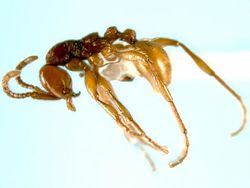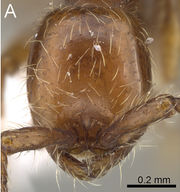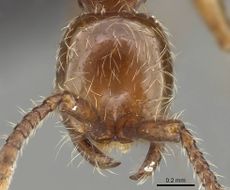Key to Aenictus ceylonicus group species of China
This worker key is based on: Staab M. 2015. Aenictus hoelldobleri sp. n., a new species of the Aenictus ceylonicus group (Hymenoptera, Formicidae) from China, with a key to the Chinese members of the group. ZooKeys. 516:137–155. doi: 10.3897/zookeys.516.9927.
Key to Chinese A. ceylonicus group species based on the worker caste, modified and updated after the key of Jaitrong and Yamane (2013) and the extension of this key by Liu et al. (2015b). That key can be found here.
You might be also be interested in
- Aenictus species groups (diagnoses)
- Key to Aenictus species groups
- The Aenictus genus page.
1
- Mandible with 2-6 teeth/denticles between subapical and basal teeth (mandible with more than 4 teeth/denticles) (Fig. 1A, B) . . . . . 2
- Mandible with 0-1 tooth/denticle between subapical and basal teeth (mandible with 3-4 teeth/denticles) (Fig. 1C, D) . . . . . 7
2
return to couplet #1
- Promesonotum entirely punctate (Fig. 4A), at most lateral face of pronotum partly smooth and shiny; dorsum of postpetiole punctate (Fig. 3A) (Guizhou) . . . . . Aenictus thailandianus
- Promesonotum predominantly smooth and shiny (Fig. 4B, C, D); dorsum of postpetiole smooth and shiny (Figs 3B, 3C, 3D) . . . . . 3
3
return to couplet #2
- Subpetiolar process weakly developed, low and rounded, not rectangular (Fig. 4B) . . . . . 4
Subpetiolar process well developed and rectangular (Figs 4C, 4D) . . . . . 5
4
return to couplet #3
- Dorsum of propodeum straight in profile, entirely microreticulate and opaque; promesonotum microreticulate except posterior half of pronotum smooth and shiny; masticatory margin of mandible with large apical tooth, followed by a small preapical tooth, and 5 minute denticles (Henan) . . . . . Aenictus henanensis
- Dorsum of propodeum weakly convex to almost straight in profile, punctate but somewhat shiny; promesonotum entirely smooth and shiny except for reticulate anteriormost portion (Fig. 3B); masticatory margin of mandible with large apical tooth followed by a series of 6-7 denticles of two sizes, the larger alternating with 1-2 smaller (Fig. 1B) (Taiwan) . . . . . Aenictus lifuiae
5
return to couplet #3
- Dorsum of mesonotum and petiolus entirely smooth and shiny (Fig. 3C) . . . . . Aenictus yangi
- Dorsum of mesonotum and petiolus finely reticulate (Fig. 3D) . . . . . 6
6
return to couplet #5
- Subpetiolar process rectangular-trapezoidal, its ventral outline with a thin almost transparent lamellae (Fig. 4C); masticatory margin of mandible with 4 (rarely 3) denticles (total number of mandibular teeth 6-7, including apical, subapical and basal tooth) (Jiangxi, Zhejiang) . . . . . Aenictus hoelldobleri
- Subpetiolar process rectangular, its apex very acute and directed downwards medially (Fig. 4D); masticatory margin of mandible with 6 denticles (total number of mandibular teeth 9 including apical, subapical and basal tooth) (Hubei, Zhejiang) . . . . . Aenictus wudangshanensis
7
return to couplet #1
- Mandible with 3 teeth including apical and basal tooth (Fig. 1C) (Guizhou) . . . . . Aenictus watanasiti
- Mandible with 4 teeth including apical and basal tooth (Fig. 1D) . . . . . 8
8
return to couplet #7
- Subpetiolar process well-developed, subrectangular with convex ventral lamella, and with anterior and posterior corners acutely or bluntly angulated (Fig. 4E); head longer than broad, at maximum as broad as long (CI 90-100) (Fig. 2B) (Taiwan, Zhejiang) . . . . . Aenictus formosensis
- Subpetiolar process weakly developed or very low (Fig. 4F, G); head broader than long, at minimum as broad as long (CI 100-112) (Fig. 2C, D) . . . . . 9
9
return to couplet #8
- Subpetiolar process very low, with anterior and posterior denticles that protrude downwards (Fig. 4G); head in full-face view subrectangular, posterior margin feebly concave (Fig. 2D) (Yunnan) . . . . . Aenictus maneerati
- Subpetiolar process weakly developed, in profile its ventral outline almost straight or weakly convex, without denticles (Fig. 4F); head in full face view not rectangular, posterior margin weakly convex or straight (Fig. 2C) (Guangxi, Hong Kong . . . . . Aenictus fuchuanensis

















